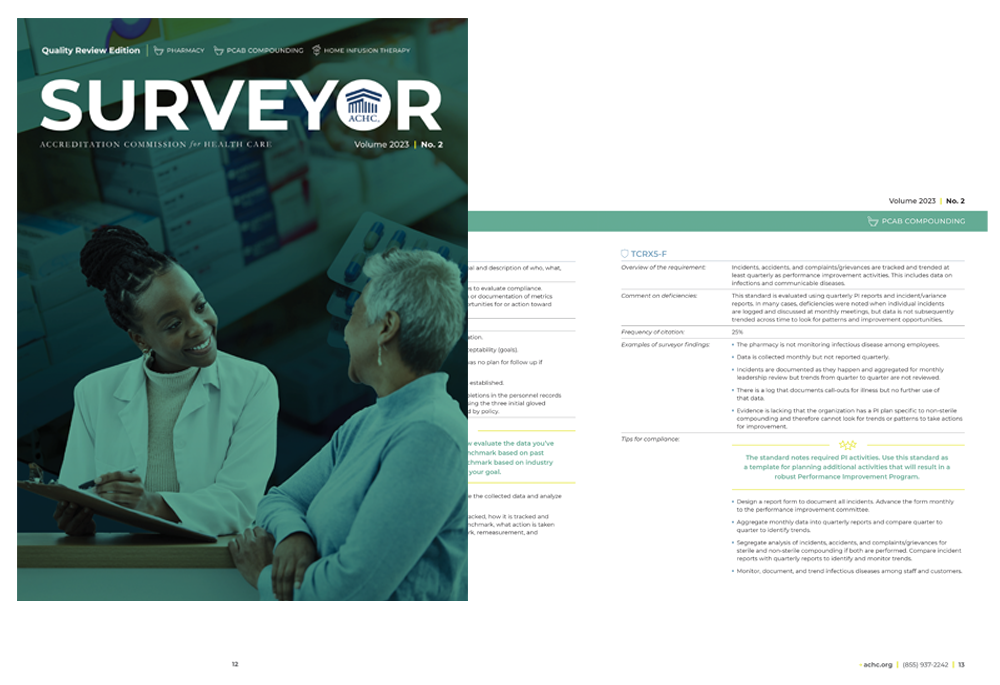The Rise of Hospital-Level In-Home Health Care: Trends, Benefits, and the Future
The healthcare landscape is undergoing a significant transformation driven by the need to innovate and adapt to changing consumer preferences and economic pressures. A growing trend within this transformation is the shift toward delivering increasingly complex care – including care that traditionally required an inpatient admission – in home settings.
ACHC has observed this trend closely and recognizes its potential to revolutionize patient care. Hospital-level care provided in the patient’s home is a natural extension of private duty and home health services that are already well-established elements in the continuum of care.

Supporting Accreditation Success
ACHC surrounds you with essential resources to empower your team and advance improvements. Our popular Surveyor Quality Review delivers valuable insights on top deficiencies and must-have tips for compliance.
Sign up now to receive a FREE copy of the latest Surveyor Quality Review.
Extending the Reach of In-Home Health Care
Several factors are driving the increased adoption of in-home healthcare services. These drivers reflect changing consumer preferences, economic considerations, advancements in technology, and evolving regulatory frameworks.
- Demographic Shifts: According to the U.S. Census Bureau, by 2030 it is estimated that one in five Americans will be age 65 or older, many with multiple chronic conditions that require ongoing management.
- Technological Advancements: Innovations in telehealth, remote patient monitoring, and wearable health devices have made it easier and more cost-effective to manage chronic conditions in the home. Telehealth platforms facilitate virtual consultations, and remote monitoring devices allow healthcare providers to track vital signs and manage status changes in real time.
- Regulatory Support and Reimbursement Changes: The expansion of reimbursement policies for telehealth and in-home care services by Medicare, Medicaid, and private insurers has made these services more accessible and financially viable. Emergency regulatory changes during the COVID-19 pandemic allowed for broader use of telehealth services, demonstrating the feasibility and effectiveness of remote care.
- Healthcare Workforce Optimization: By decentralizing care and leveraging technology, healthcare systems and home health agencies can optimize their workforces, deploying nurses, physician assistants, and homecare aides more effectively to manage patient care outside traditional hospital settings. In-home healthcare models can help address the ongoing shortage of healthcare professionals, particularly in rural and underserved areas.
- Enhanced Continuity of Care: Integrating a patient’s health management into a single, coordinated plan promotes continuity. Providers can deliver personalized care that considers the patient’s home environment, social determinants of health, and access to resources. This holistic approach can lead to better health outcomes, reduced hospitalizations, and fewer emergency room visits.
- Patient and Caregiver Empowerment: Educational tools, digital health platforms, and remote monitoring technologies enable patients to take a more active role in managing their health. Patients and caregivers benefit from support and guidance provided by healthcare professionals. This empowerment can lead to greater satisfaction and engagement among patients and their families.
The “hospital-at-home” model accelerated by the Centers for Medicare & Medicaid Services (CMS) during the COVID-19 pandemic used waivers designed to alleviate overcrowding in hospitals. But organizations focused exclusively on home-based services have also been innovating with new technology and partnerships to expand the range of services they offer. The combined result is recognition that home-based health care offers a viable solution, allowing a wide range of patients to receive services while maintaining their independence and comfort at home.
What remains is for organizations dedicated to patient safety and quality of care to step in with standards tailored to ensure that patients are appropriately screened and directed to services that meet their needs and their preferences.
ACHC expects to make an important announcement soon.

 Accreditation Commission for Health Care, Inc.
Accreditation Commission for Health Care, Inc.